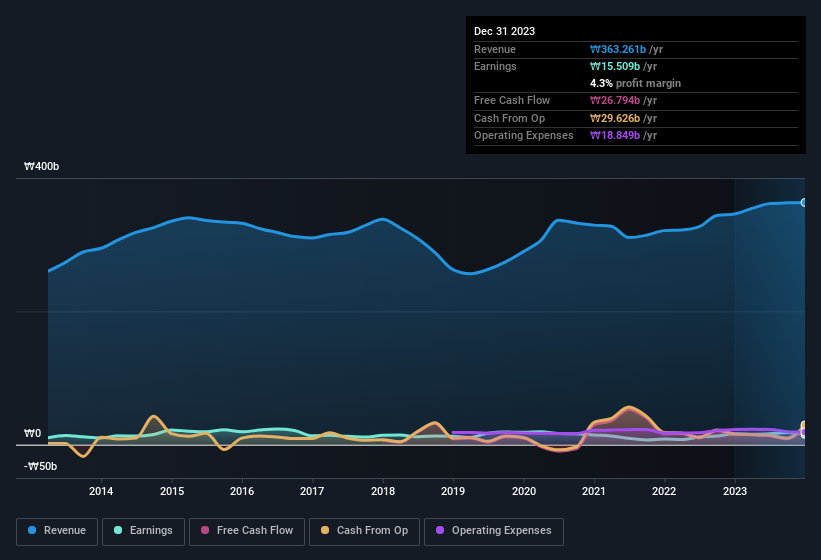- South Korea
- /
- Electric Utilities
- /
- KOSE:A130660
There May Be Some Bright Spots In Korea Electric Power Industrial Development's (KRX:130660) Earnings
Soft earnings didn't appear to concern Korea Electric Power Industrial Development Co., Ltd's (KRX:130660) shareholders over the last week. We think that the softer headline numbers might be getting counterbalanced by some positive underlying factors.
View our latest analysis for Korea Electric Power Industrial Development

Zooming In On Korea Electric Power Industrial Development's Earnings
One key financial ratio used to measure how well a company converts its profit to free cash flow (FCF) is the accrual ratio. To get the accrual ratio we first subtract FCF from profit for a period, and then divide that number by the average operating assets for the period. You could think of the accrual ratio from cashflow as the 'non-FCF profit ratio'.
Therefore, it's actually considered a good thing when a company has a negative accrual ratio, but a bad thing if its accrual ratio is positive. While it's not a problem to have a positive accrual ratio, indicating a certain level of non-cash profits, a high accrual ratio is arguably a bad thing, because it indicates paper profits are not matched by cash flow. To quote a 2014 paper by Lewellen and Resutek, "firms with higher accruals tend to be less profitable in the future".
Korea Electric Power Industrial Development has an accrual ratio of -0.16 for the year to December 2023. That implies it has very good cash conversion, and that its earnings in the last year actually significantly understate its free cash flow. To wit, it produced free cash flow of ₩27b during the period, dwarfing its reported profit of ₩15.5b. Korea Electric Power Industrial Development's free cash flow improved over the last year, which is generally good to see.
Note: we always recommend investors check balance sheet strength. Click here to be taken to our balance sheet analysis of Korea Electric Power Industrial Development.
Our Take On Korea Electric Power Industrial Development's Profit Performance
Korea Electric Power Industrial Development's accrual ratio is solid, and indicates strong free cash flow, as we discussed, above. Because of this, we think Korea Electric Power Industrial Development's earnings potential is at least as good as it seems, and maybe even better! And on top of that, its earnings per share have grown at 7.1% per year over the last three years. Of course, we've only just scratched the surface when it comes to analysing its earnings; one could also consider margins, forecast growth, and return on investment, among other factors. With this in mind, we wouldn't consider investing in a stock unless we had a thorough understanding of the risks. Every company has risks, and we've spotted 2 warning signs for Korea Electric Power Industrial Development (of which 1 doesn't sit too well with us!) you should know about.
This note has only looked at a single factor that sheds light on the nature of Korea Electric Power Industrial Development's profit. But there is always more to discover if you are capable of focussing your mind on minutiae. For example, many people consider a high return on equity as an indication of favorable business economics, while others like to 'follow the money' and search out stocks that insiders are buying. While it might take a little research on your behalf, you may find this free collection of companies boasting high return on equity, or this list of stocks that insiders are buying to be useful.
Valuation is complex, but we're here to simplify it.
Discover if Korea Electric Power Industrial Development might be undervalued or overvalued with our detailed analysis, featuring fair value estimates, potential risks, dividends, insider trades, and its financial condition.
Access Free AnalysisHave feedback on this article? Concerned about the content? Get in touch with us directly. Alternatively, email editorial-team (at) simplywallst.com.
This article by Simply Wall St is general in nature. We provide commentary based on historical data and analyst forecasts only using an unbiased methodology and our articles are not intended to be financial advice. It does not constitute a recommendation to buy or sell any stock, and does not take account of your objectives, or your financial situation. We aim to bring you long-term focused analysis driven by fundamental data. Note that our analysis may not factor in the latest price-sensitive company announcements or qualitative material. Simply Wall St has no position in any stocks mentioned.
About KOSE:A130660
Korea Electric Power Industrial Development
Korea Electric Power Industrial Development Co., Ltd.
Flawless balance sheet and slightly overvalued.
Market Insights
Community Narratives



